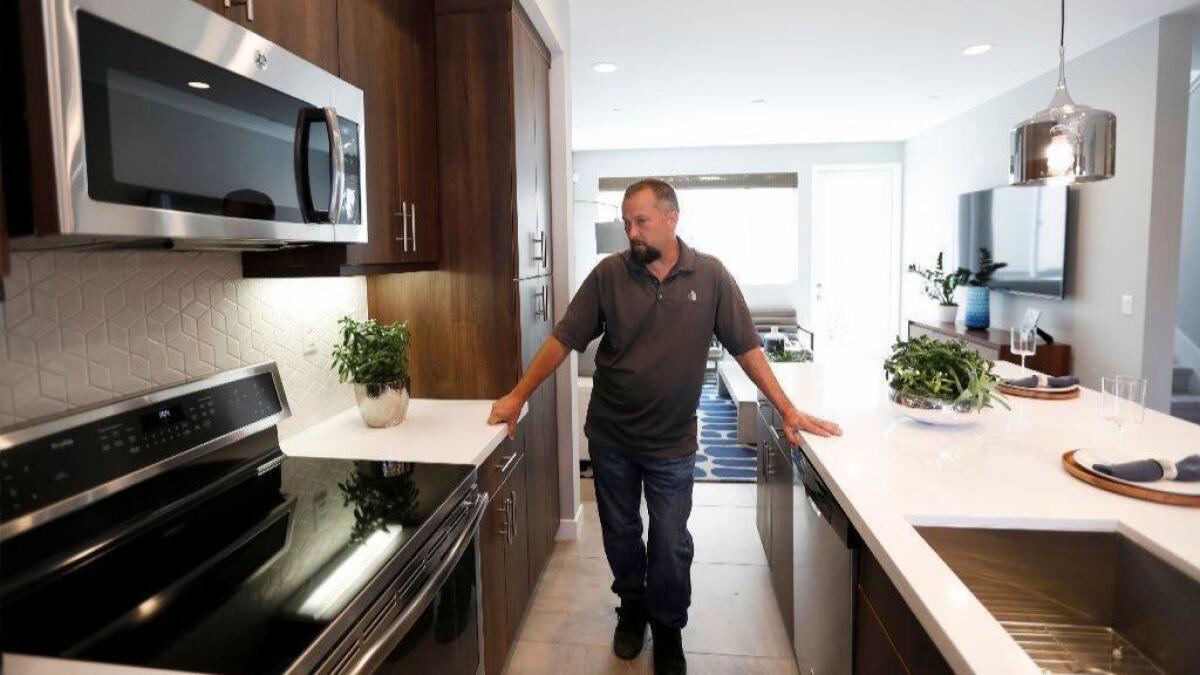Op-Ed: Berkeley banned natural gas. The rest of California should too

- Share via
By becoming the first city in the nation to ban natural gas in new low-rise buildings and homes, Berkeley did something momentous in mid-July: It signaled the beginning of the end of the natural gas era. This is an altogether good thing.
California has set a climate mandate of 100% clean, renewable energy by 2045. It won’t reach that goal unless it eliminates natural gas from buildings. Burning natural gas emits carbon dioxide and other pollutants, and its distribution and storage infrastructure leaks methane. In many cities, including Berkeley, buildings are the second leading greenhouse gas-emitting sector, after transportation. Now that regulations aimed at the 2045 mandate are in place for cars, trucks and coal-fired power, natural gas has to be next.
For the record:
1:27 p.m. Aug. 7, 2019This op-ed states that electric appliances don’t require venting. Electric hot water heaters, furnaces and dryers don’t require venting, but stove tops do.
The popular image of gas cooking and heating — clean, cheap and reliable, a “bridge fuel” from coal to renewables — requires drastic revision. Natural gas is in fact the new coal; its greenhouse gas emissions overall in the U.S. have surpassed coal’s since 2015. The California Air Resources Board calculates that natural gas emissions from the state’s 12 million buildings account for 12% of the state’s greenhouse gas emissions. Add to that a reasonable estimate of the leaks from the state’s natural gas pipelines, and according to Bruce Nilles, an electrification advocate at the Rocky Mountain Institute, that percentage likely doubles, surpassing emissions from all the state’s power plants.
Natural gas is combustible, a frequent culprit in fires and explosions and a particular menace in earthquake zones. But even without major temblors, gas pipes beneath cities pose risks. An underground gas pipe explosion in the Bay Area city of San Bruno in 2010 killed eight people and destroyed or damaged more than 100 homes, and the Aliso Canyon gas storage leak forced the evacuation of more than 8,300 households in Granada Hills for more than 100 days in 2015 and 2016.
Gas leaks from residential appliances can cause fatal asphyxiation. Even absent leaks, gas stoves emit nitrogen dioxide, a notoriously hazardous gas that induces asthma and other respiratory ailments. A 2013 Lawrence Berkeley National Laboratory study estimated that in a typical winter week, when windows are closed, 12 million Californians live in homes whose gas stoves emit enough pollutants to lift indoor pollution levels beyond Environmental Protection Agency standards for the outdoors. Indoor pollution is worse among the poor, where cramped quarters concentrate pollutants — which makes banning natural gas an environmental justice issue. Even when the pollutants are vented to the outdoors, they add to ozone, another threat to respiratory health.
Measures as forceful as the Berkeley ban, which begins in January, often attract fierce opposition. But Berkeley City Council member Kate Harrison spearheaded a six-month-long outreach program that proved so persuasive that at the hearing before the July 16 vote, not a single person spoke against the measure, not even an official from Pacific Gas & Electric, the nation’s fifth-largest distributor of natural gas. PG&E, in fact, spoke in favor of the ban. The utility — energy distributor to 16 million customers — was in effect acknowledging that its natural gas infrastructure will wind down while its electricity infrastructure expands.
The case for making new buildings all-electric is overwhelming. It costs less to install just one kind of energy — electricity — in new construction, instead of installing gas pipes too. Electric appliances don’t need venting, and the latest technologies work well: Electric heat pumps both cool and heat homes and induction cooktops are as prized by most home chefs as gas stoves. (Induction cooktops are still more expensive than gas ranges, but their price will drop as economies of scale kick in.)
The superiority of all-electric buildings underlines the perverse incentives enshrined in current state regulations. In the 1990s, before clean energy sources fed much of the electricity grid, the California Public Utilities Commission offered rebates to consumers for buying gas appliances while blocking incentives to switch to then-dirtier electricity. But with the dwindling of coal-fired energy consumption in California and the emergence of highly efficient electric appliances, those policies no longer make sense — a fact the PUC has acknowledged in a proposed rule removing barriers against switching to all-electricity. A final vote on the rule could happen in August.
At least 50 other California cities — reports cite Los Angeles, San Francisco, Santa Monica and San Jose among them — are poised to encourage all-electric new construction in coming months, according to David Hochschild, California Energy Commission chair. They may not ban gas altogether in new construction, but the aim is the same — a retreat from natural gas.
The biggest opponent of all-electric buildings is L.A.’s gas utility, Southern California Gas Co., which, not coincidentally, is the only major state utility that sells only natural gas. It has reason for concern. The Berkeley measure is a prelude to an equally essential but more difficult task: retrofitting all existing homes and buildings so that they, too, become all-electric.
Jacques Leslie is a contributing writer to Opinion.
More to Read
A cure for the common opinion
Get thought-provoking perspectives with our weekly newsletter.
You may occasionally receive promotional content from the Los Angeles Times.








